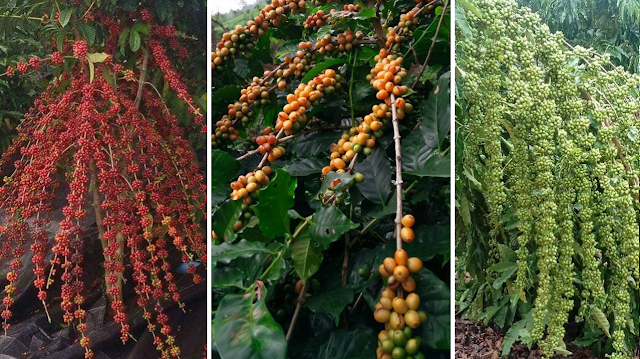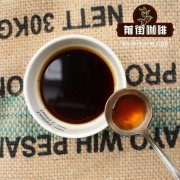The wind in the coffee market has changed! 60% of Arabica's market share was lost, and Robusta exceeded 40%!
Professional coffee knowledge exchange more coffee bean information please follow the coffee workshop (Wechat official account cafe_style)
In recent years, the industry light Robusta rather than Arabica, recognize the good flavor of coffee beans belong to Arabica. However, Arabica, which is engaged in hard work, has lost its market share of 70%, or even dropped below 60%.
According to the World Coffee report released by the United States Department of Agriculture on June 12, 2018, the total world coffee production of 174.5 million bags (60 kg each) totaled 10.47 million tons. The annual output of Robusta coffee beans has grown from 6.43 million bags to 7.01 million bags, reaching 4.2 million tons. Robusta coffee beans have exceeded 40% of the market for the second year in a row.

Has the trend of coffee changed?
The demand for coffee has soared in emerging markets. Robusta coffee beans, which have always been looked down upon, have exceeded 40% of the market. Planting Robusta has also become a craze!
Vietnam will export a record amount of coffee this year, with a surge in demand for robusta beans, which are mainly used to make instant coffee, while demand for instant coffee is increasing in the developing market.
Both Guatemala and Nicaragua in Central America are expanding their production areas of robusta beans.
Colombia used to look down on robusta coffee beans, but now it is growing in large quantities!
Robusta has also entered the general family coffee bean market because suppliers mix robusta beans with Arabica beans and sell them at low prices. In addition, Vietnam and Robusta coffee beans have an advantage in the Asian market because the transportation cost in Vietnam is only about half that of Arabica coffee beans in Latin America.
In addition, climate change is also a factor, as temperatures rise and droughts intensify, high-quality coffee beans will become more and more difficult to grow. In general, the place where high-quality Arabica beans are planted is a 25-degree range of the equator's Tropic of Cancer, known as the "coffee belt". Some experts predict that the place may be affected by the climate and cannot be produced by 2050.

It is generally believed that the most common varieties of coffee beans are Arabica and Robusta, which are known for their relative ease of growth and resistance to diseases and insect pests, and have a stable supply, but compared with Arabica coffee beans, Robusta is more exciting and bitter, while Arabica coffee beans taste sweeter and softer. However, with the sharp increase in global demand for low-cost coffee beans and the fact that climate change is detrimental to the growth of Arabica coffee beans, the coffee market in Southeast Asia is expected to rise sharply.
Take Vietnam, the world's second-largest exporter of coffee beans, as an example. Vietnam mainly produces low-cost robusta coffee beans, which now account for 25% of Japan's coffee bean imports and close to 27% of Brazil's Arabica beans. According to an analysis by the Nikkei News (Nikkei Asian Review), Robusta in Japan is mainly used to make instant coffee, which is especially suitable for the single or small family market, which has been rising rapidly recently.
Vietnam is now fighting for the export of coffee beans, hoping to expand its market share by increasing the output of beans per tree. Vietnam's coffee production grew by 4 per cent a year in fiscal 2018, according to the US Department of Agriculture. Domestic demand is also increasing, and coffee shops are now the favorite environment for young people, but three-in-one instant coffee with coffee, sugar and milk powder is still the most popular among consumers.
END
Important Notice :
前街咖啡 FrontStreet Coffee has moved to new addredd:
FrontStreet Coffee Address: 315,Donghua East Road,GuangZhou
Tel:020 38364473
- Prev

Yunnan coffee beans have become the main mixed raw material of Arabica coffee in Europe.
For more information on coffee beans, please follow the coffee workshop (Wechat official account cafe_style). According to the Financial Daily, China is changing from a traditional tea grower to a coffee producer in Asia, growing high-quality small fruit coffee (Arabica coffee), which is more attractive for international coffee groups and commodity traders to set up bases in Yunnan Province.
- Next

China coffee Hainan coffee producing area Xinglong coffee beans What varieties of Hainan coffee famous
Professional coffee knowledge exchange More coffee bean information Please pay attention to coffee workshop (Weixin Official Accounts cafe_style) Coffee in the world can be roughly divided into three native species, namely Arabica, Robusta and Liberia. Generally speaking, Arabica is the best coffee bean, which is only planted in high altitude areas. Liberia prefers high temperature and humidity and tastes lighter. Xinglong area has an altitude of 21 to 532.
Related
- What is the standard process for the purpose of coffee cup testing? What is the difference between hand-brewed coffee and cup testing?
- How to use hand-brewed coffee paragon small golden balls? How does cold coffee lock in the aroma of coffee?
- Is American coffee black? What is the difference between American coffee and drip coffee?
- Unexpected! Well-known tea beverage brand Lele Tea will withdraw from the Zhengzhou market!
- Starbucks enters the fashion and beauty industry?! Netizen: Give me an ice American eye cream
- Why can American refills for free? The difference between Americano and American drip pot coffee
- Being chased out of the rain in front of Starbucks?! Store: Sheltering from rain under umbrellas poses a safety hazard
- The white moonlight has changed?! Lucky launches "Big Winter Pear American"
- Hand-brewed coffee three-stage method, high-sweet and universal brewing method to share! What does the high sweet water level of hand-brewed coffee mean?
- What is the difference between raw, refined and full espresso coffee? How to extract espresso and taste good?

